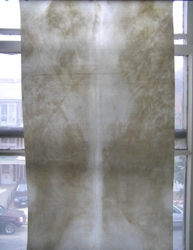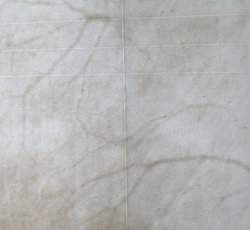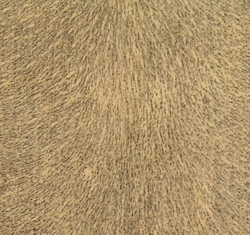 This morning in the synagogue we read Exodus 13:9, which contains the phrase "The Torah of God shall be in your mouth."
This morning in the synagogue we read Exodus 13:9, which contains the phrase "The Torah of God shall be in your mouth."Rabbinic tradition expands this concept: if we are to put the Torah in our mouths, it obviously cannot be made of things that we may not eat. So all animal products used on Torahs are made from the kosher species.
Quills - swan or goose feathers, turkey or duck, but no peacock or ostrich, eagle or crow. Glue - before synthetic glues, sticky stuff was mostly made from animal products, did you know that? - fish glue or cow-hoof glue, but not rabbit-skin glue or horse-hoof glue. Thread, which is made from tendons and glue - cow tendons, but not horse tendons. And parchment.
Torahs are written on parchment, in Hebrew klaf, קלף, (with a kuf). Proper parchment is really a type of leather - here's a site which talks about how klaf is made. Nowadays most Torah parchment is made from cows, because the meat industry mostly deals with cows; older Torahs are often goat, one also sees deer and occasionally sheep; you could use bison, or chicken or turkey (but that would make very small pieces, and probably not be worth it). You could even use a giraffe, if you could find one.
And yes, I have this dream that one day someone will give me a dead giraffe and I will be able to write a Megillah on it, because you could fit the whole Megillah on one giraffe skin* and that would be unbelievably amazing so if you do know anyone with giraffes that are looking a bit tottery, do introduce me, or if you know a parchment-maker who's up for an adventure, likewise.
I digress.
The one kosher animal you may not use is a fish. Klaf can be made out of fishskin, but the rabbinic sources say that it smells truly terrible, and for that reason you can't use it for sacred scrolls - you don't want your holy books to be stinky. This I like very much.
Goat parchment retains a distinctive goaty tang for a Very Long Time - goats are like that, very assertive - and you can usually identify a goat Torah because it smells like a goat. I like this too, it is a pleasing reminder that the scroll is not just a text, it is a physical object as well.
The picture at right is a piece of klaf held up against a window. You can see very clearly where the cow's backbone was. Sometimes you can also see where the kidneys were, and if it had a fat bottom, sometimes you see that as well.

 The two images at left are close-ups of the surface of klaf. The top picture is the front side, and the bottom picture is the back side. A word about that, first: if you're processing parchment for a book, you make both sides the same, because you want to write on both sides of the page. But we only write on one side for our scrolls, so we only bother processing one side. That means that the front side is beautifully smooth and silky, almost like very very fine suede, but the back side is rougher and generally less "finished."
The two images at left are close-ups of the surface of klaf. The top picture is the front side, and the bottom picture is the back side. A word about that, first: if you're processing parchment for a book, you make both sides the same, because you want to write on both sides of the page. But we only write on one side for our scrolls, so we only bother processing one side. That means that the front side is beautifully smooth and silky, almost like very very fine suede, but the back side is rougher and generally less "finished."You can see that the front side has lines on it. All Torahs have to be written with lines - it's both a scribal aid, to keep the lines straight, and an halakhic (legal) requirement - i.e. even if you're really good at keeping your lines straight, you still have to have lines. You probably didn't notice them last time you read Torah, but they're almost certainly there - you just don't notice them because you're looking at the letters.
The lines are scored in. One can score one's own lines, with a ruler and some kind of scoring tool, such as an awl, or one can have the lines put in by the klafmachers (people who make the parchment). That's very clever - they have a grid of wires, and they set the wires to the appropriate positions, and then they press it hard into the klaf, bang, and that makes lines. Sort of like when your socks leave a line pattern in your ankle, only the klaf is dead so they don't fade away quickly like they do on ankles. Sometimes they will fade with extreme age, hence that "almost" above.
So anyway, on the front side of this particular piece you can also see the veins. The front side is generally bleached quite white and nice, but sometimes hints of animal-ness remain.
On the back side of this piece, you can see the hair pattern quite distinctly. The back will often keep some of the colour of the cow - greyish, brownish, whatever. Sometimes it's splotchy. I think that's rather lovely.
On most older scrolls, you won't see the splotching, because for a long time it was the fashion to paint the backs with a substance called log, to make them uniformly white. This undoubtedly makes the backs of the scrolls attractively white and shiny, but unfortunately it also makes the scrolls extremely heavy. Log is some variety of sticky substance mixed with some variety of white powder, for instance boiled klaf and powdered chalk, so when coating, you're effectively adding a layer of stone to the Torah, and of course that's going to be heavy.
So these days we don't coat the backs, we whiten the parchment by bleaching it, and any remaining discolouration serves to remind us of the complex relationship between animals and Jewish ritual worship. We generally get one sheet of parchment per cow, which works out to about sixty-five cows per Torah; that's a lot of cows.
I have explored the ethical implications of this in two related blog posts, here and here, but the intertwined ethics of the contemporary meat industry and the Jewish community's response have only just started to develop, so that particular aspect of Torah-making is one which will evolve in the direction we choose to take it.
Moadim le'simcha, as they say; continue to have an enjoyable matzah festival.
* Technically you would have to cut it into sheets because you mayn't have more than eight columns on a sheet, but that's okay, I'm very good at tiny neat seams, so the pattern wouldn't be too obviously disrupted.




No comments:
Post a Comment